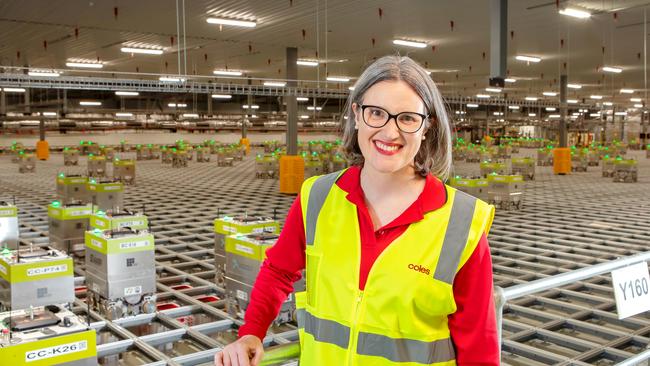Coles opens new Melbourne fulfilment centre in $1.4bn shopping upgrade
Coles boss Leah Weckert has overseen a $1.4bn investment in robotic distribution facilities and fulfilment centres but believes the retailer’s balance sheet is strong enough to do more.

Coles chief executive Leah Weckert says the supermarket giant’s latest customer fulfilment centre in Melbourne is the final piece in a $1.4bn infrastructure investment strategy to deliver world-class technology and automation that will improve its consumer offer and its competitive edge.
And Ms Weckert isn’t ruling out more investment in state-of-the-art distribution centres and robot-run facilities to pick, pack and send groceries to online shoppers, with the Coles balance sheet strong enough to pour more investment into its backend operations.
“We definitely do have good flexibility in the balance sheet, which is a great place to be … but I think as we look forward, further automation of our supply chain over the next five to 10 years, that would definitely be something that we will be considering as part of our strategic planning,” Ms Weckert told The Australian as she opened its new fulfilment centre in Truganina, 20km west of the Melbourne CBD.
Coles has spent $1.4bn on its two fulfilment centres and two automated distribution facilities.
It recently opened automated centre in Brisbane and Sydney. Coles is building a fulfilment centre in Sydney and has opened one in Melbourne.
“Today’s opening signals a major step change in our online grocery deliveries that will offer our customers greater choice, better availability, improved freshness and more flexible delivery options,” Ms Weckert said as she opened the building alongside Victoria’s acting Premier Tim Pallas and Coles chairman James Graham.
The Truganina site has a footprint of more than 87,000sq m – four times the size of the Melbourne Cricket Ground. It can hold three million units of stock and process more than 10,000 customer orders per day when running at full capacity.
Built by global tech firm Ocado, the new Melbourne fulfilment centre will employ more than 1000 staff, including drivers and fulfilment staff that will use hi-tech packing equipment. There will also be a fleet of more than 200 home delivery vans.
Ms Weckert said the new fulfilment centres in Melbourne and Sydney will help transition Coles from a local, store-based fulfilment model to a central, world-class facility that will enable the retailer to better serve the greater Melbourne region, home to more than five million people.
“The capacity that we have built out here (in Truganina) is definitely for the long term. It’s the equivalent of about 40 new stores of capacity that we’ve built and is now available to us in Victoria … which is really exciting from a growth perspective for the business.
“And the four facilities altogether, that is completing this stage of automation that we’ve had going now, really since 2019.”
As a battle rages between Coles, Woolworths and new grocery platforms such as Amazon, Ms Weckert said she believed the four facilities would boost Coles’s customer offer, increasing speed, efficiency and online services where delivery times are crucial.
“I think what is exciting at all four of the facilities is we are actually seeing the benefits that we built into the business case coming through in terms of the customer benefits, but also the productivity and efficiency benefits that we get for Coles as an organisation,” she said.
Turning to trading, Ms Weckert said there had been no change in consumer spending or shopping behaviour since the company’s full-year results in August, which that threw a spotlight on cost-of-living pressures squeezing household budgets.
“It is pretty stable with what we shared at the full-year results. There are still a lot of customers shopping around, researching prices, willing to get in the car and travel (for savings), and obviously a lot of trading down going on at the moment as customers look for more affordable options to make the budget balance,” she said.
“But at the same time, eating out less, and so doing a bit more shopping at the supermarket to meet their meal needs.”




To join the conversation, please log in. Don't have an account? Register
Join the conversation, you are commenting as Logout